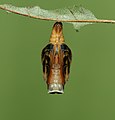Neptis jumbah
| Chestnut-streaked sailer | |
|---|---|

| |
| Scientific classification | |
| Domain: | Eukaryota |
| Kingdom: | Animalia |
| Phylum: | Arthropoda |
| Class: | Insecta |
| Order: | Lepidoptera |
| Family: | Nymphalidae |
| Genus: | Neptis |
| Species: | N. jumbah
|
| Binomial name | |
| Neptis jumbah Moore, 1857
| |
Neptis jumbah, the chestnut-streaked sailer,[1][2] is a species of nymphalid butterfly found in South Asia.[1][2]
Description
[edit]
The male somewhat resembles Neptis columella, but differs as follows: Upperside fuliginous black, the interspaces between the veins deeper black, very conspicuous in certain lights, particularly so between the subbasal and postdiscal markings on the hindwing; the white markings suffused with very pale bluish green; the posterior two spots of the discal series on the forewing subequal; the postdiscal macular band on the hindwing with a tendency to obsolescence, varying from a narrow series of white lunules to a somewhat diffuse transverse narrow pale band. On the underside the ground colour is paler than in N. columella, the interspaces between the veins conspicuously much darker; the postdiscal and subterminal markings on both forewings and hindwings diffuse and very ill-defined. N. jumbah can also be recognized by the discal transverse series of comparatively large dark brown spots.[3]
In the female the spots on the forewing and the subbasal band on the hindwing are comparatively broader than they are in the male; in the dry-season form of both sexes, as compared with the wet-season form, often conspicuously broader. Antennae, head, thorax and abdomen as in N. columella.[3][4]
Wingspan 62–70 mm.
Distribution
[edit]The species is found in southern India, the Nilgiris the Western Ghats, northeast India, Myanmar, the Andaman Islands and Sri Lanka. (Specimens from the Andamans have the lilacine-white terminal markings on the underside very broad and diffuse.)[3][1][2]
Larva
[edit]"Somewhat fusiform, anterior and anal segments narrowed, the middle segments being thickened laterally, aimed with two dorsal, long, anteriorly-divergent fleshy processes on the fourth segment, and two shorter posteriorly-divergent similar processes on the twelfth segment, also two very short dorsal spiny tubercles on the third and sixth segments. Head cleft and pointed at the vertex. Colour brownish-purple, anal segments dark purple-brown spotted with green and bordering an oblique line extending laterally from anal spine to base of spine on fourth segment; two short, oblique, dorsal anteriorly-oblique (?) lateral streaks along middle segments." (Moore.)[3]
Pupa
[edit]"Suspended vertically; slender in the abdominal part with a sharp dorsal ridge, much stouter and broader in the thoracic region; with wing-cases expanded laterally; two sharp points on. the head; colour varying from dark brown to dull white, suffused and touched at points with gold" (Davidson and Aitken)[3]
Gallery
[edit]-
fifth instar caterpillar
-
Freshly formed pupa
-
Mature pupa
-
Newly eclosed
See also
[edit]References
[edit]- ^ a b c R.K., Varshney; Smetacek, Peter (2015). A Synoptic Catalogue of the Butterflies of India. New Delhi: Butterfly Research Centre, Bhimtal & Indinov Publishing, New Delhi. p. 191. doi:10.13140/RG.2.1.3966.2164. ISBN 978-81-929826-4-9.
- ^ a b c "Neptis Fabricius, 1807" at Markku Savela's Lepidoptera and Some Other Life Forms
- ^ a b c d e
 One or more of the preceding sentences incorporates text from this source, which is in the public domain: Bingham, Charles Thomas (1905). Fauna of British India. Butterflies Vol. 1. pp. 327–328.
One or more of the preceding sentences incorporates text from this source, which is in the public domain: Bingham, Charles Thomas (1905). Fauna of British India. Butterflies Vol. 1. pp. 327–328.
- ^
 One or more of the preceding sentences incorporates text from this source, which is in the public domain: Moore, Frederic (1896–1899). Lepidoptera Indica. Vol. III. London: Lovell Reeve and Co. pp. 220–223.
One or more of the preceding sentences incorporates text from this source, which is in the public domain: Moore, Frederic (1896–1899). Lepidoptera Indica. Vol. III. London: Lovell Reeve and Co. pp. 220–223.




